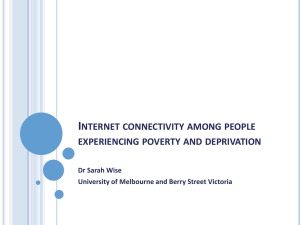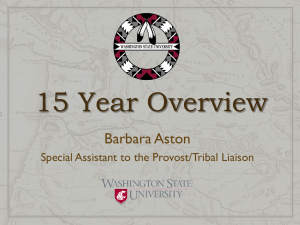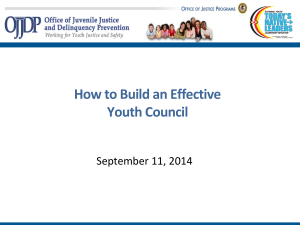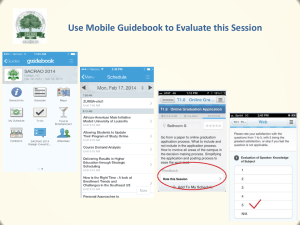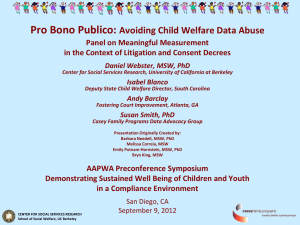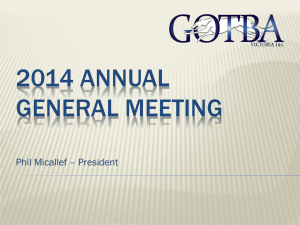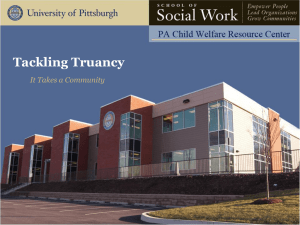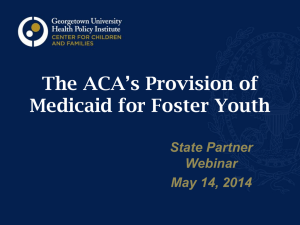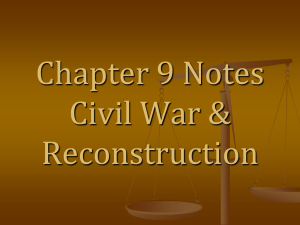NICWA needs assessment presentation
advertisement
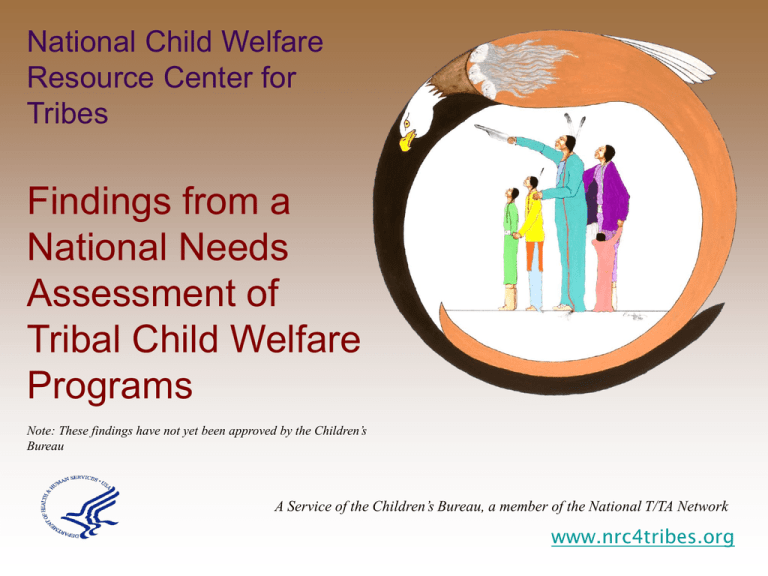
National Child Welfare Resource Center for Tribes Findings from a National Needs Assessment of Tribal Child Welfare Programs Note: These findings have not yet been approved by the Children’s Bureau A Service of the Children’s Bureau, a member of the National T/TA Network www.nrc4tribes.org The National Resource Center for Tribes (NRC4Tribes) joined the Children’s Bureau Training and Technical Assistance (T/TA) Network to provide and broker training and technical assistance to support the enhancement of tribal child welfare systems. We provide training and technical assistance at no cost through the T/TA Network to eligible tribes. www.NRC4Tribes.org 2 The Partnership Our Leadership Team: Who we are Jerry Gardner Kathy Deserly Deb Painte Robin Leake Executive Director, Tribal Law and Policy Institute Associate Director, NRC4Tribes Director, Native American Training Institute Research Manager, Butler Institute for Families, DU Director, NRC4Tribes Director, Indian Child and Family Resource Center Joe Walker Evaluation Specialist, Native American Training Institute Miriam Bearse Tribal Child Welfare Specialist NRC4Tribes: Tribal Law and Policy Institute Dr. Cathryn Potter Executive Director, Butler Institute for Families, DU Establishing a shared vision… The NRC4Tribes Leadership Team - comprised of TLPI and its partner agencies held a facilitated strategic planning session to plan the five year implementation of the NRC4Tribes. As four separate entities, the agency staff felt the importance of developing a common vision, mission, philosophy and guiding principles specifically for the NRC4Tribes. 5 The vision… The vision of the National Resource Center for Tribes (NRC4Tribes) is to facilitate the empowerment of Native Nations to nurture the safety, permanence and well-being of American Indian/Alaska Native children, families and communities by offering culturally relevant information, resources and technical assistance so that the dreams and sacrifices of the ancestors are fulfilled and honored. 6 The mission… Our mission is, as members of the Children’s Bureau T/TA Network, to collaborate with Native Nations and our training and technical assistance partners to identify and effectively implement community, culturally based strategies and resources that strengthen tribal child and family services. 11 The philosophy… Children are sacred and entitled to be cherished in a safe and nurturing environment with strong family, community and cultural connections. Their happiness and well-being includes nourishment of mind, body and spirit in order to fulfill their dreams throughout their journey toward becoming a healthy Elder. 12 NRC4Tribes Needs Assessment Purpose Listen to tribal child welfare program staff, families and community stakeholders talk about program strengths, gaps and challenges. Gather relevant information, which can then be distilled into an accurate profile of the tribal child welfare system. Inform Decisions about types of services, administrative functions, data and information collection, program management and reporting. Provide Information about the training and technical assistance available to tribes. 9 NRC4Tribes Needs Assessment Consultants Team of tribal child welfare experts from across the country Selected to: • Gather assessment data • Advise on methods, tools, and outreach • Conduct on-site assessments and telephone interviews Signed confidentiality agreement and followed data protocols Needs Assessment Methods General Online Survey Web-based & paper/pencil survey 85-items; checklists, multiple choice, open-ended All stakeholders invited to participate 262 surveys completed by representatives of more than 100 tribes Tribal Director Telephone Interviews 2-hr. telephone interviews conducted with 31 tribal child welfare directors across 6 Children’s Bureau regions (7 BIA regions; 10 states) Onsite Assessments 20 IV-B funded tribes invited; 16 accepted 149 in-person interviews conducted 42 staff surveys 11 Participation in Needs Assessment All participation was completely voluntary General on-line interview link e-mailed and mailed directly to tribes; marketing through fliers, newsletters, websites and ads Tribes for on-site and telephone interviews selected through stratified sample based on geographic region and size Tribes invited through e-mails, written mail and follow-up telephone calls 12 Respondents More than 400 individuals participated through either a survey or interview These respondents represented 127 federallyrecognized tribes 42.8% of general survey respondents were involved with the tribal child welfare agency 45.6% of interviewees were tribal child welfare staff; 17.4% were foster parents and youth; and 37% were other stakeholders 13 Needs Assessment Participants by BIA Regions Alaska = 9.0% 7.6% 9.0% 6.8% Eastern = 6.3% Eastern Oklahoma = 3.8% 6.3% 3.8% 8.2% Great Plains = 14.7% Midwest = 17.2% Navajo = .8% 14.7% 9.3% Northwest = 10.1% Pacific = 6.3% 6.3% Rocky Mountain = 9.3% 17.2% 10.1% Southern Plains = 8.2% Southwest = 6.8% 0.8% N = 367 Western = 7.6% Needs Assessment Participants by CB Regions 0.5% 0.0% 3.5% Region 1 = 3.5% (CT, MA, ME, NH, RI, VT) 1.9% Region 2 = .5% (NJ, NY, PR, VI) 19.5% 17.1% Region 3 = 0% (DC, DE, MD, PA, VA, WV) Region 4 = 1.9% (AL, FL, GA, KY, MS, NC, SC, TN) Region 5 = 17.1% (IL, IN, MI, MN, OH, WI) 13.9% Region 6 = 17.3% (AR, LA, NM, OK, TX) 17.3% Region 7 = 5.1% (IA, KS, MO, NE) Region 8 = 21.3% (CO, MT, ND, SD, UT, WY) 21.3% 5.1% N = 376 Please note that during data collection for this needs assessment (July–October 2010), there were no federally recognized tribes in Region 3. Region 9 = 13.9% (AZ, CA, HI, NV, Pacific Islands) Region 10 = 19.5% (AK, ID, OR, WA) Onsite and Telephone Needs Assessments 25.0% 20.8% 20.0% 14.8% 15.0% 9.4% 10.0% 5.4% 5.0% 2.7% 0.0% N = 149 6.0% 6.7% 9.4% 9.4% 15.4% Preliminary Data Initial analysis has focused on three questions: What are the existing strengths of tribal child welfare programs? What are the current challenges that tribal child welfare programs face? What types of training or technical assistance (T/TA) are needed by tribal child welfare programs? Where can the NRC4Tribes best focus its T/TA efforts with tribal child welfare programs? 17 Findings: Needs Assessment Topic Areas 1) Tribal Child Welfare Practice Child welfare practice, culturally based services, service challenges, infrastructure, and workforce issues 2) Foster Care and Adoption Tribal foster care, recruitment, licensing, training, and adoption 3) Indian Child Welfare Act Collaborations with state/county child welfare programs, courts 4) Legal and Judicial Children’s Codes, participants’ experiences working with state/county and tribal courts and child protection teams 5) Tribal Child Welfare Program Operations Experiences with tribal/state agreements and funding Topic Area #1 Tribal Child Welfare Practice Infrastructure elements necessary for effective tribal child welfare programs A documented practice model A Tribal Children’s Code that aligns with the practice model, reflects the culture and value of the tribe, and meets federal child welfare requirements Job descriptions and staff performance reviews Formal assessment protocols and case management processes Electronic management information systems (MIS) 19 Tribal Child Welfare Practice Workforce issues Child welfare workforce is the area of greatest strength and greatest challenge for tribal child welfare programs Staff strengths Experience, skills, knowledge Ability to engage with families Commitment to doing whatever it takes to keep families together and children safe Staff cohesion and peer support Use of traditional practices to heal both families and themselves 20 Tribal Child Welfare Practice Workforce challenges Staff are overworked, overwhelmed, and burned out Staff is at a high risk for experiencing vicarious, or secondary, traumatization that can threaten physical and emotional well-being and work effectiveness Programs have difficulty recruiting qualified candidates Programs have difficulty providing needed training in critical areas of child welfare practice Tribal Child Welfare Practice Cultural Strengths “Continuous efforts are made to ensure maximum participation in cultural activities and cultural education for the children and families served. Staff are required to participate in educational activities.” “I would say just our knowledge of the local people is a strength. That would be a prevention in itself. And being able to find relatives in a timely manner.” “Our tribe through the child welfare agency has developed a specialized model of practice that is a hybrid, incorporating both cultural as well as mainstream options for families involved in the child welfare system.” 22 Challenges: Program Operations and Services Lack of funding for operations and services Lack of prevention services Lack of staff “I think money is a downfall and staffing and resources. Those are all of our bad areas. Foster care payments are hard, and our funds are limited so we can’t offer a lot of things that we want to make this a better program.” “You might hear a lot of times, ‘we’ve only got one person.’ You have no idea what that is like, the impact of what that is like. I think it’s a barrier toward a better communication and any child welfare procedure, whether it’s strengthening from the beginning and working on a prevention road or if it’s working with a family that has children in custody. If you don’t have the staff then you’re limited.” 23 Other Challenges Collaborating with state or county child welfare departments Lack of knowledge and understanding by non-Indians of ICWA, tribal life, values, practices and history Accessing services & working with service providers “I would say we’re working more with the other non-profits rather than the state to figure out a better way to serve our people ... Well, we try to work with the state but they seem to have their own agenda and it’s hard, it’s really hard to work with them because, I mean for various reasons, but it’s kind of a contentious relationship.” “We do live in a very rural area so I think that transportation is a huge barrier for us as far as our families having access to those services.” 24 Topic Area #2 Foster Care and Adoption The majority of tribes felt that foster care programs should be managed by the tribe to keep children in their families and tribal communities to maintain their connections to tribal culture and tradition Resources for program operations and worker salaries; foster home recruitment; and foster parent subsidies were described as “inadequate.” 25 Foster Care and Adoption “We don’t do very many adoptions. Our tribal code is a little bit different than other tribal codes. Under some circumstances with parental consent, there can be an adoption without termination of parental rights. Frequently, when that happens, it’s another family member that’s doing the adoption and the parent permanently gives up custody but still retains some visitation rights of some sort.” –Tribal Court Judge Foster Care and Adoption T/TA Needs Assistance for tribal foster care workers, so they may become more familiar with state/county foster care policies, regulations, and procedures Coordination between tribal and state/county child welfare programs to provide the most comprehensive level of support and services possible to tribal foster parents and foster children Better assessment of the needs of children being placed in tribal foster homes Increased training and preparation for tribal foster parents Ability to inform tribal foster parents more thoroughly of state/county regulations and to assist in helping them determine if they have met these requirements 27 Topic Area #3 Indian Child Welfare Act (ICWA) Most tribes reported that states and counties comply with ICWA by notifying them when member children are taken into the custody of these departments; they reported very few jurisdictional disputes. However, many felt that state/county workers did not understand or correctly interpret ICWA, and that this created a barrier to collaborating successfully on ICWA cases. 28 Indian Child Welfare Act (ICWA) State/county workers often were seen as not accepting the need for ICWA and lacking awareness of important cultural aspects and tribal processes, such as enrollment. Tribes reported that they do not have the financial resources and staff capacity necessary to address the large number of ICWA cases in states and counties across the United States that involve their member children. 29 Indian Child Welfare Act Issues and Needs Development of tribal ICWA policies and procedures Resources for more tribal workers dedicated to ICWA cases Timely receipt of ICWA notifications from states and counties Need for training of state and county workers on ICWA legal and practice aspects Increasing state and county workers’ understanding of why ICWA is needed Increasing understanding and awareness of tribes and reservation contexts on the part of state and county workers Increased compliance with ICWA placement preferences, especially placement with extended family and other tribal kin Widely differing perceptions on the parts of tribal and state/county child welfare staff regarding the quality and level of state/tribal collaboration and state ICWA compliance Challenge: Continuing adoption of tribal children by non-Indians in state and 30 county courts Topic Area #4 Legal and Judicial A majority of tribes administer their own tribal court and have access to an attorney either working directly for the child welfare agency or as a staff attorney for the tribe. Many participants believed that their tribal children’s codes need revisions to make them more specific to the tribe’s culture and traditions. Several participants reported that their tribe did not have a children’s code but was in the process of developing one. 31 Legal and Judicial Majority of participants identified the Child Protection Team (CPT) concept as the team most widely utilized in reviewing child welfare cases. Tribal CPTs were generally composed of: Tribal child welfare staff, community members, tribal enrollment, law enforcement, tribal court staff, behavioral health staff, and social services directors FBI, U.S. attorney, BIA, state/county social workers, schools, CASAs, judges, attorneys, and prosecutors 32 Topic Area #5 Tribal Child Welfare Operations Nearly half participating tribes currently have a tribal/state agreement. Tribes that liked their agreements were likely to: Have an agreement that clarifies jurisdictional authority and how services are provided Meet regularly with state child welfare representatives who were part of state or tribal advisory committees, forums, or CPT/MDT groups Have a close working relationship with at least one key individual from the state child welfare system The tribe agreed with the terms The agreement was consistently honored by the state The tribe and state worked collaboratively to serve Indian children 33 and families in a culturally appropriate way Tribal Child Welfare Operations Those tribes that reported challenges working with their tribal/state agreements cited: A lack of communication A lack of state/county adherence to the terms and spirit of the agreement (especially the failure of states to notify tribes as per ICWA) Issues with the agreement 34 Tribal Child Welfare Operations Program Funding—Title IV-B 45% reported currently receiving Title IV-B funding Primary reasons for not receiving Title IV-B funding included: a time-consuming application and management process (35%) a lack of information about the process (21%) eligibility (14%) other reasons (28%), such as lack of buy in from their tribal court or state/county agencies 35 “We don’t have the funding to hire more staff that can be on call. Staff are needing to update training skills each year, but the funding isn’t there for staff to attend trainings, and to maybe even go to other Indian sites to see how they’re doing things, and get contacts from there.” –Tribal Child Welfare Director 36 Tribal Child Welfare Operations Program Funding—Title IV-E through Tribal/State Agreements 68% of survey respondents were familiar with Title IV-E funding 47% of respondents currently receive Title IV-E funding through a tribal/state IV-E agreement 37 Tribal Child Welfare Operations Program Funding—Direct Title IV-E funding Many participating tribes stated that they were interested in learning more about direct Title IV-E funding 22 % were definitely interested 21 %were definitely not interested 57 % were unsure Some tribes shared that they were in the beginning stages of IV-E planning, or are considering options 38 Tribal Child Welfare Operations So I think if these technical services are provided upfront on an individual tribe basis based on the number of IV-E cases, it will give a clear picture whether tribes should go into contract in their own IV-E as well as what’s to be expected and how do we sustain that and how many numbers before we hit the threshold before it’s actually going to be beneficial for that tribe to do so. So I think it would help . . . that the feds, the state share that information to each tribe so that we can make a sound decision for our community. – Tribal Child Welfare Director 39 Summarized T/TA Recommendations Recommendation 1: Support the strengthening of the tribal child welfare program infrastructure to improve practice Recommendation 2: Support the use of culturally based practices in tribal child welfare Recommendation 3: Partner with the T/TA Network to support the development of MISs for tribal child welfare programs Recommendation 4: Promote the development and maintenance of successful tribal foster care and adoption (permanency) programs Recommendation 5: Support the strengthening and improvement of tribal/state relationships 40 Summarized T/TA Recommendations Recommendation 6: Build tribal child welfare peer networks Recommendation 7: Address workforce issues in tribal child welfare programs Recommendation 8: Enhance multidisciplinary collaboration for prevention services Recommendation 9: Ensure a targeted T/TA that meets the individualized needs of tribes Recommendation 10: Partner with other federal agencies within the ACF, the BIA, and others to model effective systems of care that will support tribal child welfare programs 41 In conclusion . . . Today we presented a few emerging themes from just some of the data Perspectives of directors interviewed and survey respondents are aligned “Our tribe through the child welfare agency has developed a specialized model of practice that is a hybrid incorporating both cultural as well as mainstream options for families involved in the child welfare system. We embrace and recognize the importance and effectiveness of traditional practices and spiritual healing through ceremonies.” 42 National Child Welfare Resource Center for Tribes For More Information: Jerry Gardner Executive Director, TLPI Director, NRC4Tribes Jerry@TLPI.org 323-650-5467 Kathy Deserly Associate Director NRC4Tribes Kathy@NRC4Tribes.org 406-431-5941 NRC4Tribes Miriam Bearse Tribal Child Welfare Specialist NRC4Tribes Miriam@NRC4Tribes.org 323-877-6886 43
